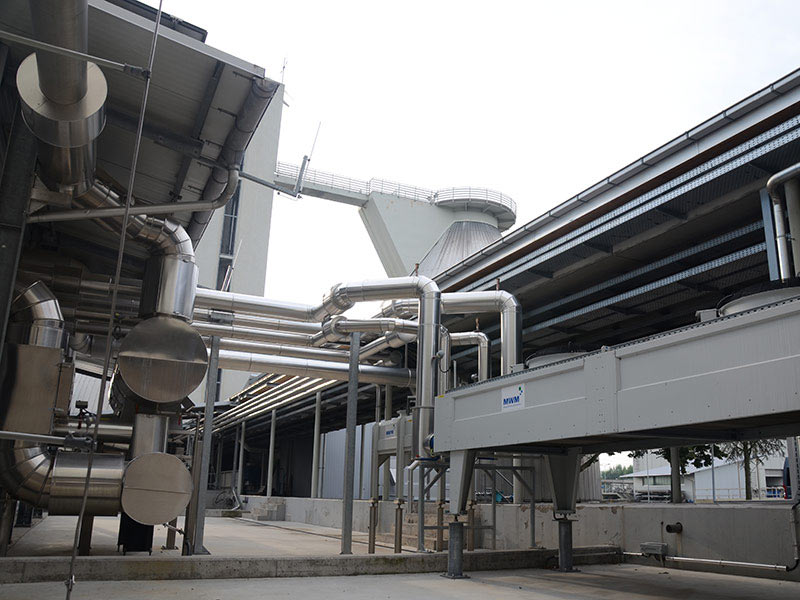Weinheim Waste Treatment Plant
The Weinheim Waste Treatment Plant produces some 150% of its own electricity use
Waste water treatment is an energy-intensive business – waste treatment plants used to be responsible for the lion’s share of electricity required by communities. In the meantime, combined heat and power plants for power production have become firmly established as standard equipment within waste water treatment plants. The Weinheim Waste Treatment Plant in the Bergstrasse Waste Water Utility District is no exception in this regard. Located just outside the city of Weinheim an der Bergstrasse, the waste treatment plant, commissioned in 1977 and completely overhauled in 1993, produces electricity from fermentation gas with two MWM cogeneration power plants. “With our particularly efficient and continuously optimized plant, we cover not only our own complete annual requirement for electricity, but we can also feed up to 1,800 MW back into the public grid,” as Manuel Ritter, manager of the waste water plant, proudly explains. At the age of 24, Manuel Ritter is Germany’s youngest waste water plant manager, already earning his master craftsman’s certificate at 22.

Waste water treatment beyond state boundaries
Bergstrasse Waste Water Utility District encompasses the Hessian and Baden-Wuerttemberg communities of Weinheim, Viernheim, Birkenau, Hemsbach, Hirschberg, Laudenbach, along with the “Grundelbachtal” Waste Water Utility. Currently the waste water from some 170,000 people is biologically treated and cleaned in the Weinheim Waste Treatment Plant. Yet the system is designed for a waste water treatment capacity of 230,000 to 240,000 inhabitants. Depending upon rainfall, the plant processes between 20,000 and 130,000 m3 of waste water per day, producing up to 7t of fermentation sludge daily as a byproduct of water treatment. The fermentation tanks, a typical visual characteristic of waste treatment plants, generate roughly 2,400,000 m3 of fermentation gas per year. “Our plant is designed to achieve an extremely high gas yield during the fermentation process – we increase the efficiency through filtering and drying,” says the plant manager, illustrating the sewage treatment plant’s energy efficiency.

The fermentation tanks, a typical visual characteristic of waste treatment plants, generate roughly 2,400,000 m3 of fermentation gas per year. “Our plant is designed to achieve an extremely high gas yield during the fermentation process – we increase the efficiency through filtering and drying,” says the plant manager, illustrating the sewage treatment plant’s energy efficiency.

Precaution against power outages and grid disruptions
“Thus far we have been operating two cogeneration systems, each equipped with a 400 kWel and a 600 kWel genset from MWM. A third CHP plant with 600 kWel from MWM is currently under construction and is expected to be ready for operation at the end of 2014,” explains Manuel Ritter. “It will enable us to cover 100 percent of our own substantial electricity requirement and simultaneously use the heat generated for the heating of our buildings and of fermentation towers that require a temperature of 37°C for the fermentation processes.”

The gas gensets of the cogeneration systems in the Bergstrasse Waste Water Utility District reach some 7,500 annual operating hours. The third CHP plant currently under construction is a redundancy unit, as the failure of a CHP plant would result in unnecessary energy costs. With the third MWM TCG 2016V 12 genset, a high-performance system is available as a “standby CHP plant.” Since the commissioning of sewage treatment plant in 1977, there has been seamless cooperation between the waste water utility district and the Mannheim-based gas engine manufacturer.
Further proof of the waste water treatment plant’s energy efficiency is the use of solar energy – in addition to the CHP plant, the Bergstrasse Waste Water Utility District installed over 5,000 m2 of photovoltaic panels on the roof tops of the waste water treatment building, which yield up to 560,000 kWh/year. Together with the cogeneration power plants, they produce up to 162 percent of their own electricity requirement.
Weinheim Waste Treatment Plant
Bergstrasse Waste Water Utility District
Altau 10
69469 Weinheim/Bergstrasse
Germany
Technical specifications waste treatment plant
| Waste water volumes: | 20.000 – 130.000 m3/day 12.000.000 – 18.500.000 m3/year |
| Fermentation sludge: | approx. 7 t/d (solids) |
| Fermentation tanks: | 3 fermentation tanks, 4,700 m3 each |
| Gas production: | ca. 2.400.000 m3/year |
| Power production: | ca. 5.600.000 kWh/year, equivalent to approx. 147 % of the plant’s own requirement |
| Heat output: | approx. 5,340,000 kWh/year |
| Commissioning: | 1977 |
Technical specifications CHP
| Commissioning: | 2006 (400 kWel) 2011 (600 kWel) Ende 2014 (600 kWel) |
| Engine type: | 1 x MWM TBG 2016 V12K – 469 kWel 2 x MWM TCG 2016 V12C – 600 kWel |
| Electrical output: | 1 x 400 kWel, 2 x 600 kWel |
| Electrical efficiency: | approx. 42.5 % |
| Thermal efficiency: | approx. 40.5 % |
| Overall efficiency: | approx. 83.0 % |






































